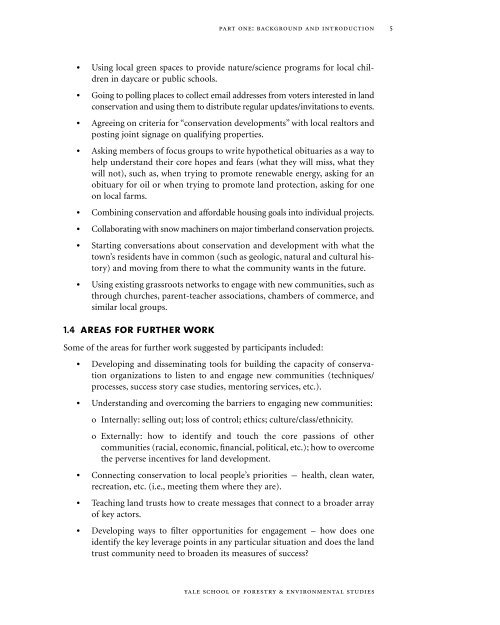Strategies for the Future of Conservation - Yale University
Strategies for the Future of Conservation - Yale University
Strategies for the Future of Conservation - Yale University
Create successful ePaper yourself
Turn your PDF publications into a flip-book with our unique Google optimized e-Paper software.
part one: background and introduction5●●●●●●●●Using local green spaces to provide nature/science programs <strong>for</strong> local childrenin daycare or public schools.Going to polling places to collect email addresses from voters interested in landconservation and using <strong>the</strong>m to distribute regular updates/invitations to events.Agreeing on criteria <strong>for</strong> “conservation developments” with local realtors andposting joint signage on qualifying properties.Asking members <strong>of</strong> focus groups to write hypo<strong>the</strong>tical obituaries as a way tohelp understand <strong>the</strong>ir core hopes and fears (what <strong>the</strong>y will miss, what <strong>the</strong>ywill not), such as, when trying to promote renewable energy, asking <strong>for</strong> anobituary <strong>for</strong> oil or when trying to promote land protection, asking <strong>for</strong> oneon local farms.Combining conservation and af<strong>for</strong>dable housing goals into individual projects.Collaborating with snow machiners on major timberland conservation projects.Starting conversations about conservation and development with what <strong>the</strong>town’s residents have in common (such as geologic, natural and cultural history)and moving from <strong>the</strong>re to what <strong>the</strong> community wants in <strong>the</strong> future.Using existing grassroots networks to engage with new communities, such asthrough churches, parent-teacher associations, chambers <strong>of</strong> commerce, andsimilar local groups.1.4 areas <strong>for</strong> fur<strong>the</strong>r workSome <strong>of</strong> <strong>the</strong> areas <strong>for</strong> fur<strong>the</strong>r work suggested by participants included:●●●●●Developing and disseminating tools <strong>for</strong> building <strong>the</strong> capacity <strong>of</strong> conservationorganizations to listen to and engage new communities (techniques/processes, success story case studies, mentoring services, etc.).Understanding and overcoming <strong>the</strong> barriers to engaging new communities:o Internally: selling out; loss <strong>of</strong> control; ethics; culture/class/ethnicity.o Externally: how to identify and touch <strong>the</strong> core passions <strong>of</strong> o<strong>the</strong>rcommunities (racial, economic, financial, political, etc.); how to overcome<strong>the</strong> perverse incentives <strong>for</strong> land development.Connecting conservation to local people’s priorities — health, clean water,recreation, etc. (i.e., meeting <strong>the</strong>m where <strong>the</strong>y are).Teaching land trusts how to create messages that connect to a broader array<strong>of</strong> key actors.Developing ways to filter opportunities <strong>for</strong> engagement – how does oneidentify <strong>the</strong> key leverage points in any particular situation and does <strong>the</strong> landtrust community need to broaden its measures <strong>of</strong> success?yale school <strong>of</strong> <strong>for</strong>estry & environmental studies
















